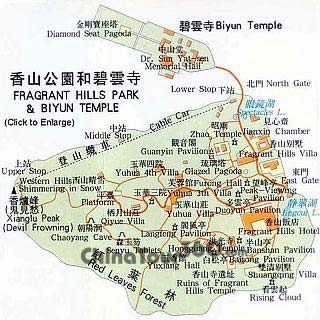 |
| Fragrant Hills Park Map |
The Fragrant Hills Park is famous for the maple leaves and got its name accordingly. Located 10 kilometers (about 6.2 miles) to the west of Beijing, 160-hectare (about 395 acres) park has lovely stretches of gardens as well as numerous historical relics.
The park was first established in 1186 during the Jin Dynasty (1115 - 1234). Over the years Ming and the Qing emperors added to the park, calling it the garden of tranquility and pleasure. In 1745, Emperor Qianlong ordered large-scale construction. At that time, 28 beautiful scenes with enclosing walls were set up and named Jingyi Park by the emperor. Unfortunately, almost every trace of this carefully orchestrated symphony of landscape architecture, including the blueprints, was burned or destroyed by the Anglo-French forces and the eight-Power Allied Forces in the 19th and early 20th centuries.
The brilliant foliage is the main attraction of the park. No one is sure where the sumac trees originated. There is also a legend tells that a south wind carried the seeds of the red-leaf trees to Beijing. Then the seeds survived, and as years passed they grew into a lovely forest. Another story goes that the sumacs were transplanted to the area by Emperor Qianlong (l736 - l795) of the Qing Dynasty (1644 - 1911). In November, the frosted leaves of these trees, along with the persimmons and maples, spread over the Fragrant Hills like a thick red blanket. For two centuries, it has been a resort for the residents in Beijing.
There are three convenient roads for enjoying the park. The northern route goes over the Spectacle Lake bridge. The landscaped part of the park, called Study of Reading Heart, and the Tibetan style Bright Temple are also on the northern route. The Bright Temple was once the home of the 6th Panchen Lama, and its bells make lovely music. Along the middle road are Tingxue, Purple Mist, and Wangfeng Pavilions, Zhisong Garden, Lotus Lawn, Yuhua Villa, Snow-On-the-West Mountain, Incense-Burner Peak, Chongyang Garret, etc. For those choose the southern path can view the tranquil Green Lake, the Fragrant Temple and most importantly the Incense Burner Peak. The route up is steep, so those who don't wish to exert themselves can take the cable car.
Easily reached by public transport, this popular recreational area features an excellent series of clearly marked paths and a chairlift allows visitors to select pleasant low-level, tranquil forest or strenuous hill walking. The best time to visit the park is late autumn, when the maple tree leaves turn red. The trees make the grandest display of all scattering all over the hills and look absolutely lovely. There are also groves of apricots, pears, peaches and lilacs adding their fragrance, and the more solemn evergreens, whose contribution to the local beauty is unrestricted by seasonal changes.
![]() Tickets:
Tickets:
A. Entrance Fee: CNY 10 (Apr. 1 to Nov. 15); CNY 5 (Nov. 16 to Mar. 31);
B. Entrance Fee for Biyun Temple: CNY10;
C. Cable Car: CNY 50 for a single trip (CNY 60 on weekends and holidays, CNY 20 for children).
![]() Transportation: Take Bus No. 318, 331, 360, 634, 714, 696, 698 and get off at Xiang Shan stop.
Transportation: Take Bus No. 318, 331, 360, 634, 714, 696, 698 and get off at Xiang Shan stop.
![]() Opening Hours:
Opening Hours:
06:00 - 18:30 (Apr. 1 to Jun. 30); 06:00 - 19:00 (Jun. 1 to Aug. 31);
06:00 - 18:30 (Sep. 1 to Nov. 15); 06:00 - 18:00 (Nov. 16 to Mar. 31)








